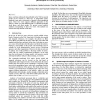Free Online Productivity Tools
i2Speak
i2Symbol
i2OCR
iTex2Img
iWeb2Print
iWeb2Shot
i2Type
iPdf2Split
iPdf2Merge
i2Bopomofo
i2Arabic
i2Style
i2Image
i2PDF
iLatex2Rtf
Sci2ools
100
click to vote
GIS
2009
ACM
2009
ACM
Analysis of community-contributed space- and time-referenced data
Space- and time-referenced data published on the Web by general people can be viewed in a dual way: as independent spatiotemporal events and as trajectories of people in the geographical space. These two views suppose different approaches to the analysis, which can yield different kinds of valuable knowledge about places and about people. We present several analysis methods corresponding to these two views. The methods are suited to the large amounts of the data.
| Added | 09 Nov 2009 |
| Updated | 09 Nov 2009 |
| Type | Conference |
| Year | 2009 |
| Where | GIS |
| Authors | Gennady Andrienko, Natalia Andrienko, Peter Bak, Slava Kisilevich, Daniel Keim |
Comments (0)

